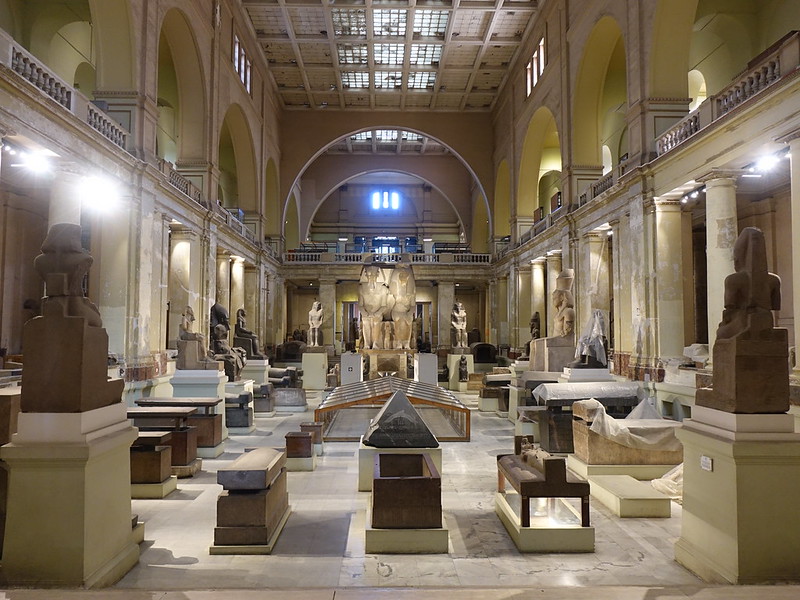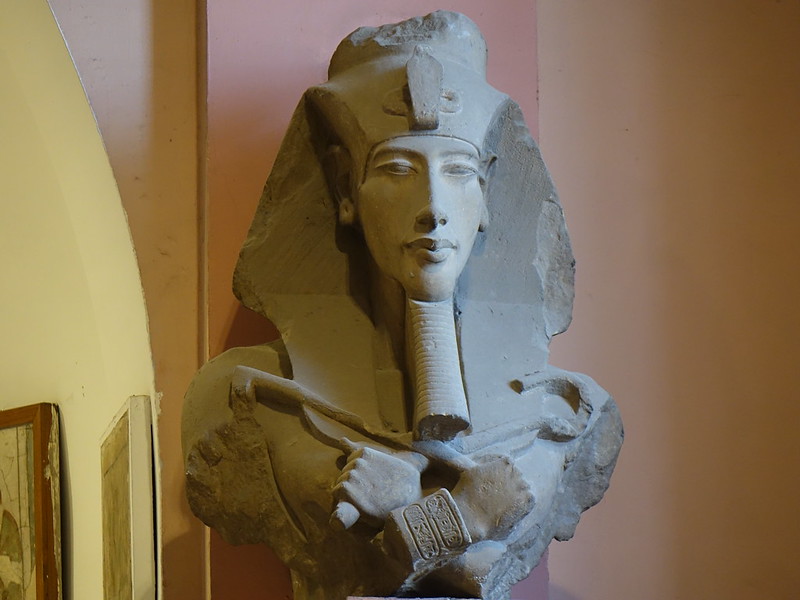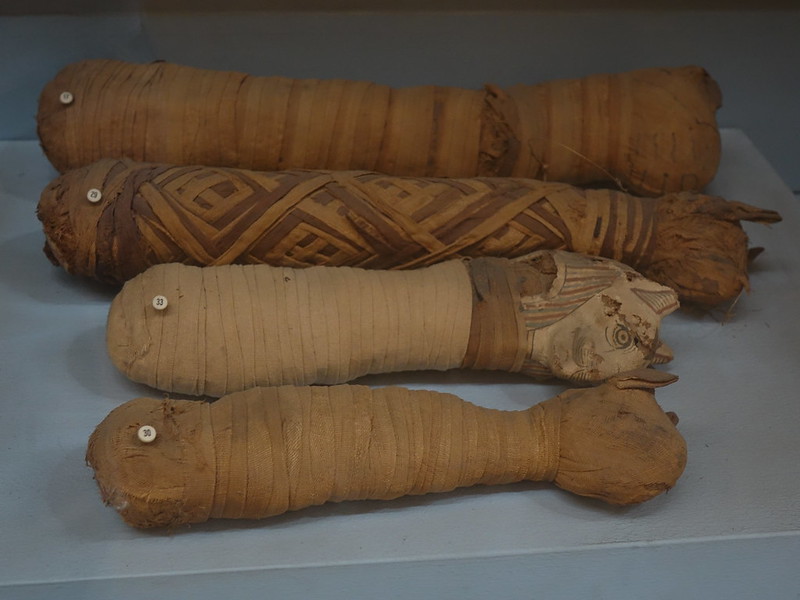Blog TWHS Visits
The Egyptian Museum
While we are working diligently on the TWHS project, in Paris they are slowly adding updated Tentative Lists. A surprise came in last week with the inclusion of ‘The Egyptian Museum in Cairo’. Rumours about it being considered first appeared in 2019, but faded out since. The submission comes at a remarkable moment as the new ‘Grand Egyptian Museum’ in Giza is almost ready to open. 50,000 pieces including the Tutankhamun collection will then have been relocated from the old museum to the new.

The "Museum of Egyptian Antiquities", as the original museum is officially called, is one of the most notable museums in the world. It has been in the same building since 1901 and with 120,000 Ancient Egyptian artefacts on display, it is the world's largest Egyptology museum. Egypt hopes to prove its OUV along the lines of purpose-built museum design and the important contribution to Egyptology as field of study.
I visited the museum in October 2018. I will record my experiences here in some detail as what you see and where you find it in the museum may already have changed in 2021. I arrived at 9am - coming early in the morning or late afternoon seems to be the best recipe against the crowds that are always here. As many as 2.5 million visitors show up in a ‘normal’ year. I found at least 150-200 people already waiting in the courtyard for the doors to open.
Once inside, after a second security check, all tourists and their guides piled up in the first rooms. However, I immediately continued to the rear rooms on the ground floor. Room 3 at the very back of the ground floor is dedicated to the period of Pharaoh Akhenaten. These finds look very different from the other Ancient Egyptian art: faces were portrayed much more lifelike.

Then I immediately went up the stairs to the first floor. This actually has more to offer than the ground floor. A hall and a corridor are dedicated to the famous finds from Tutankhamun's tomb. The highlight is of course the golden death mask, which is located in a separate room and may not be photographed. In the corridor are the larger burial finds such as a golden throne. The most beautiful I found the alabaster canopic jar - 4 white burial vases containing the remains of the organs of Tutankhamun, which were removed before he was mummified.
Almost every tourist comes here with a guide, and apparently they all call on a fixed set of highlights. I had also made a list beforehand with the most interesting rooms and objects, but it is just as nice to just walk into a room and see what catches your eye. All objects here are actually masterpieces, which other museums in the world would pay a lot for.
Upon entering I had bought an extra ticket for the "royal mummies" exhibition. I found it in a small and crowded room. Apparently many people are fascinated by those shriveled heads and bodies. I didn't like it much. The mummified animals in a room next to it I found a lot more interesting. The ancient Egyptians mummified everything: crocodiles, ibises, oxen, dogs, cats. Sometimes they were pets, accompanying their owners in the afterlife. But they were also sacred animals or just "food" to sustain the deceased in the grave.

When we evaluate the Egyptian Museum for WH status, the main question will be whether it is still attractive enough in comparison to the Grand Egyptian Museum in Giza. Its pros are its prime location (even the epicentre of Egypt’s 2011 Revolution), the quality and cohesity of its collection, its long history as a museum in general. The purpose-built museum was the first of its kind in the Middle East, it showed the Egyptian discoveries in Egypt instead of being whisked away to Western Europe. So why would it be less important than Berlin’s Museum Island for example?
Els - 14 February 2021
Comments
khuft 18 February 2021
Actually, why Egyptology was certainly dominated by Europeans at the time, Egypt was not yet a British protectorate, but instead nominally a part of the Ottoman Empire (and in reality a quasi-independent state. Before the Egyptian museum was built, the collection of antiquities was apparently kept in an annex of one of the palaces of the khedive of Egypt, who also inaugurated the Egyptian museum. So "colonial" is a bit misleading in this case...
Jay T 15 February 2021
It's true the museum is a colonial museum -- in fact modern Egyptology itself is deeply entwined with colonialism. The downside of Egyptology in the 18th and 19th centuries was that many treasures were taken away to Europe and a black market for goods from tombs was established. However, colonialism also brought the establishment of the Department of Antiquities in the 19th century, which led to the construction of the Egyptian Museum in the early 20th century to display the department's treasures, and eventually led to Egyptians gaining autonomy over their own heritage.
As a side note, I do wonder what the impetus for UNESCO World Heritage would have been if it were not for Egyptology...
Nan 14 February 2021
Hmn. I think it's hard to separate the content from the location. The Museumsinsel is great because you can walk through the Gates of Babylon. Or visit Pergammon. Will be interesting to see what goes where @kyle.
@jay good phrasing for ouv. still, this is a colonial museum, so clearly traces back to europe.
Jay T 14 February 2021
I would hazard that one point of OUV is that it was an early attempt to keep and showcase a culture’s archaeological treasures and artifacts in country, rather than taken to other countries for display. I agree that the heart of the OUV would be in the treasures on display, but the building itself provided an early example of displaying antiquities within the cultural region they were found, instilling a sense of ownership by the people. I am really curious to see what happens with this TWHS when the new museum opens, though.
Kyle Magnuson 14 February 2021
It seems mostly irrelevant if some of the highlights are moved to other modern facilities. From what I read, tens of thousands of artifacts are in storage and rotated into the exhibits. Furthermore, Egypt is not lacking in priceless treasures. In our Connection "Museum History", WHS containing locations that have been important in international museum history, none are outside Europe. That alone makes me supportive at least in theory, but I lack first hand knowledge of the museum itself.
Nan 14 February 2021
I think the comparison with the Museumsinsel is off. The Museumsinsel was built roughly 90 years before the Egyptian Museum. I also don't see OUV if the collection is removed.
The connection to the Museumsinsel is rather via it's most prominent artefact: the bust of Nofretete. But then you would also have to name the British Museum ;)